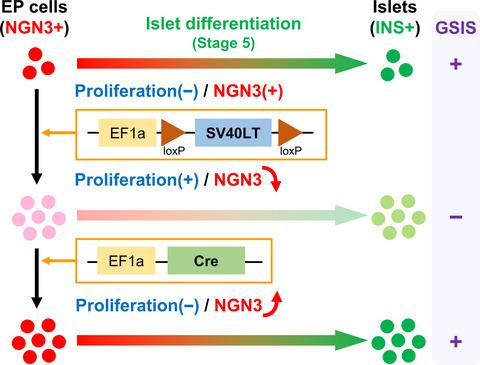当前位置:
X-MOL 学术
›
Genes Cells
›
论文详情
Our official English website, www.x-mol.net, welcomes your feedback! (Note: you will need to create a separate account there.)
Reversible expansion of pancreatic islet progenitors derived from human induced pluripotent stem cells.
Genes to Cells ( IF 2.1 ) Pub Date : 2020-03-06 , DOI: 10.1111/gtc.12759 Anna Tanaka 1 , Ami Watanabe 1 , Yasuhiro Nakano 1 , Masahito Matsumoto 2, 3 , Yasushi Okazaki 2 , Atsushi Miyajima 1
Genes to Cells ( IF 2.1 ) Pub Date : 2020-03-06 , DOI: 10.1111/gtc.12759 Anna Tanaka 1 , Ami Watanabe 1 , Yasuhiro Nakano 1 , Masahito Matsumoto 2, 3 , Yasushi Okazaki 2 , Atsushi Miyajima 1
Affiliation

|
Transplantation of pancreatic islets is an effective therapy for severe type 1 diabetes. As donor shortage is a major problem for this therapy, attempts have been made to produce a large number of pancreatic islets from human pluripotent stem cells (hPSCs). However, as the differentiation of hPSCs to pancreatic islets requires multiple and lengthy processes using various expensive cytokines, the process is variable, low efficiency and costly. Therefore, it would be beneficial if islet progenitors could be expanded. Neurogenin3 (NGN3)-expressing pancreatic endocrine progenitor (EP) cells derived from hPSCs exhibited the ability to differentiate into pancreatic islets while their cell cycle was arrested. By using a lentivirus vector, we introduced several growth-promoting genes into NGN3-expressing EP cells. We found that SV40LT expression induced proliferation of the EP cells but reduced the expression of endocrine lineage-commitment factors, NGN3, NEUROD1 and NKX2.2, resulting in the suppression of islet differentiation. By using the Cre-loxP system, we removed SV40LT after the expansion, leading to re-expression of endocrine-lineage commitment genes and differentiation into functional pancreatic islets. Thus, our findings will pave a way to generate a large quantity of functional pancreatic islets through the expansion of EP cells from hPSCs.
中文翻译:

源自人类诱导的多能干细胞的胰岛祖细胞的可逆扩增。
胰岛移植是治疗严重的1型糖尿病的有效方法。由于供体短缺是该疗法的主要问题,因此已经尝试从人多能干细胞(hPSC)产生大量胰岛。但是,由于将hPSC分化为胰岛需要使用各种昂贵的细胞因子进行多个冗长的过程,因此该过程可变,效率低且成本高。因此,如果可以扩大胰岛祖细胞,将是有益的。衍生自hPSC的表达Neurogenin3(NGN3)的胰腺内分泌祖细胞(EP)表现出分化为胰岛的能力,而其细胞周期却被阻滞。通过使用慢病毒载体,我们将几个促进生长的基因引入了表达NGN3的EP细胞中。我们发现SV40LT表达诱导EP细胞增殖,但降低了内分泌谱系承诺因子NGN3,NEUROD1和NKX2.2的表达,从而抑制了胰岛的分化。通过使用Cre-loxP系统,我们在扩增后去除了SV40LT,从而导致内分泌谱系承诺基因的重新表达并分化为功能性胰岛。因此,我们的发现将为通过hPSCs中EP细胞的扩增产生大量功能性胰岛铺平道路。导致内分泌谱系承诺基因的重新表达并分化为功能性胰岛。因此,我们的发现将为通过hPSCs中EP细胞的扩增产生大量功能性胰岛铺平道路。导致内分泌谱系承诺基因的重新表达并分化为功能性胰岛。因此,我们的发现将为通过hPSCs中EP细胞的扩增产生大量功能性胰岛铺平道路。
更新日期:2020-03-06
中文翻译:

源自人类诱导的多能干细胞的胰岛祖细胞的可逆扩增。
胰岛移植是治疗严重的1型糖尿病的有效方法。由于供体短缺是该疗法的主要问题,因此已经尝试从人多能干细胞(hPSC)产生大量胰岛。但是,由于将hPSC分化为胰岛需要使用各种昂贵的细胞因子进行多个冗长的过程,因此该过程可变,效率低且成本高。因此,如果可以扩大胰岛祖细胞,将是有益的。衍生自hPSC的表达Neurogenin3(NGN3)的胰腺内分泌祖细胞(EP)表现出分化为胰岛的能力,而其细胞周期却被阻滞。通过使用慢病毒载体,我们将几个促进生长的基因引入了表达NGN3的EP细胞中。我们发现SV40LT表达诱导EP细胞增殖,但降低了内分泌谱系承诺因子NGN3,NEUROD1和NKX2.2的表达,从而抑制了胰岛的分化。通过使用Cre-loxP系统,我们在扩增后去除了SV40LT,从而导致内分泌谱系承诺基因的重新表达并分化为功能性胰岛。因此,我们的发现将为通过hPSCs中EP细胞的扩增产生大量功能性胰岛铺平道路。导致内分泌谱系承诺基因的重新表达并分化为功能性胰岛。因此,我们的发现将为通过hPSCs中EP细胞的扩增产生大量功能性胰岛铺平道路。导致内分泌谱系承诺基因的重新表达并分化为功能性胰岛。因此,我们的发现将为通过hPSCs中EP细胞的扩增产生大量功能性胰岛铺平道路。



























 京公网安备 11010802027423号
京公网安备 11010802027423号